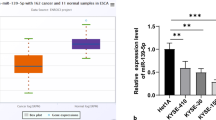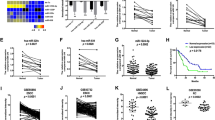Abstract
Previous studies verified that miR-214 is of great significance in the invasion and migration of a variety of cancers. It has been demonstrated that UDP-N-acetyl-α-D-galactosamine:polypeptide N-acetylgalactosaminyltransferase 7(GALNT7) is a putative target of miR-214. We performed this study to figure out how miR-214 and GALNT7 play their roles in the invasion and migration of esophageal squamous cell carcinoma (ESCC). The expression of miR-214 was significantly downregulated in tumors compared to the corresponding non-tumor tissues while GALNT7 showed an opposite tendency. The low expression of miR-214 and the high expression of GALNT7 were found positively correlated with poor tumor differentiation (P = 0.004), tumor invasion (P = 0.013), and lymph node metastasis (P = 0.012) in ESCC patients. Functional study demonstrated that overexpression of miR-214 or knockdown of GALNT7 could weaken invasive and migratory ability in Eca109, TE1, and KYSE150. Moreover, tumorigenicity assay showed us mice injected with cells containing miR-214 mimic or GALNT7 small interfering RNA formed substantially smaller tumors than that in miR-214 inhibitor group. Consequently, we concluded that miR-214 shows potential to be a diagnostic marker and therapeutic target in ESCC.







Similar content being viewed by others
References
Forman D, Ferlay J. The global and regional burdon of cancer. In: Stewart BW, Wild CP, editors. World cancer report 2014. Lyon: International Agency for Research on Cancer; 2014. p. 26–69.
Jemal A, Bray F, Center MM, et al. Global cancer statistics. CA Cancer J Clin. 2011;61(2):69–90.
Palladino Davis AG, Mendez BM, Fisichella PM, Davis CS. Dietary habits and esophageal cancer. Dis Esophagus. 2015;28(1):59–67.
Mayne GC, Hussey DJ, Waston DI. microRNAs and esophageal cancer—implications for pathogenesis and therapy. Curr Pharm Des. 2013;19(7):1211–26.
Bartel DP. MicroRNAs: genomics, biogenesis, mechanism, and function. Cell. 2004;116(2):281–97.
Wang F, Lv P, Liu X, Zhu M, Qiu X. microRNA-214 enhances the invasion ability of breast cancer cells by targeting p53. Int J Mol Med. 2015;35(5):1395–402.
Wang Z, Yin H, Zhang Y, et al. miR-214-mediated downregulation of RNF8 induces chromosomal instability in ovarian cancer cells. Cell Cycle. 2014;13(22):3519–28.
Wang YS, Wang YH, Xia HP, Zhou SW, Schmid-Bindert G, Zhou CC. MicroRNA-214 regulates the acquired resistance to gefitinib via the PTEN/AKT pathway in EGFR-mutant cell lines. Asian Pac J Cancer Prev. 2012;13(1):255–60.
Shih TC, Tien YJ, Wen CJ, et al. microRNA-214 downregulation contributes to tumor angiogenesis by inducing secretion of hepatoma-derived growth factor in human hepatoma. J Hepatol. 2012;57(3):584–91.
Yang TS, Yang XH, Wang XD, Wang YL, Zhou B, Song ZS. miR-214 regulate gastric cancer cell proliferation, migration and invasion by targeting PTEN. Cancer Cell Int. 2013;13(1):68.
Huang SD, Yuan Y, Zhuang CW, et al. MicroRNA-98 and microRNA-214 post-transcriptionally regulate enhancer of zeste homolog 2 and inhibit migration and invasion in human esophageal squamous cell carcinoma. Mol Cancer. 2012;11:51.
Zhou Y, Hong L. Prediction value of miR-483 and miR-214 in prognosis and multidrug resistance of esophageal squamous cell carcinoma. Genet Test Mol Biomarkers. 2013;17(6):470–4.
Brockhausen I. Mucin-type O-glycans in human colon and breast cancer: glycodynamics and functions. EMBO Rep. 2006;7(6):599–604.
Li W, Ma H, Sun J. MicroRNA34a/c function as tumor suppressors in Hep2 laryngeal carcinoma cells and may reduce GALNT7 expression. Mol Med Rep. 2014;9:1293–8.
Peng RQ, Wan HY, Li HF, Liu M, Li X, Tang H. MicroRNA-214 suppresses growth and invasiveness of cervical cancer cells by targeting UDP-N-acetyl-alpha-D-galactosamine: polypeptide N-acetylgalactosaminyltransferase 7. J Biol Chem. 2012;287:14301–9.
Taniuchi K, Cerny RL, Tanouchi A, et al. Overexpression of GalNAc-transferase GalNAc-T3 promotes pancreatic cancer cellgrowth. Oncogene. 2011;30:4843–54.
Penna E, Orso F, Taverna D. miR-214 as a key hub that controls cancer networks: small player, multiple functions. J Invest Dermatol. 2015;135(4):960–9.
Duan HF, Li XQ, HY H, et al. Functional elucidation of miR-494 in the tumorigenesis of nasopharyngeal carcinoma. Tumour Biol. 2015. doi:10.1007/s13277-015-4281-6.
Sharma T, Hamilton R, Mandal CC. miR-214: a potential biomarker and therapeutic for different cancers. Future Oncol. 2015;11(2):349–63.
Gaziel-Sovran A, Segura MF, Di Micco R, Collins MK, Hanniford D, de Vega-Saenz M, et al. MiR-30b/30d regulation of GalNAc transferases enhances invasion and immunosuppression during metastasis. Cancer Cell. 2011;20(1):104–18.
Ten Hagen KG, Fritz TA, Tabak LA. All in the family: the UDPGalNAc: polypeptide N-acetylgalactosaminyltransferases. Glycobiology. 2003;13:1R–16R.
Berindan Neagoe I, Monroig Pdel C, Pasculli B, Calin GA. microRNAome genome: a treasure for cancer diagnosis and therapy. CA Cancer J Clin. 2014;64(5):311–36.
Acknowledgments
Our study was supported by the National Natural Science Foundation of China (grant number 81472688, 81301829).
Author information
Authors and Affiliations
Corresponding author
Ethics declarations
Approved by the Medical Ethics Committee of Changhai Hospital, tumor specimens and corresponding adjacent normal tissue specimens, at least 5 cm far from the tumor lesion margin, were collected from consenting patients.
ᅟ
Conflicts of interest
None
Additional information
Qijue Lu, Li Xu, and Chunguang Li contributed equally to this work.
Rights and permissions
About this article
Cite this article
Lu, Q., Xu, L., Li, C. et al. miR-214 inhibits invasion and migration via downregulating GALNT7 in esophageal squamous cell cancer. Tumor Biol. 37, 14605–14614 (2016). https://doi.org/10.1007/s13277-016-5320-7
Received:
Accepted:
Published:
Issue Date:
DOI: https://doi.org/10.1007/s13277-016-5320-7




